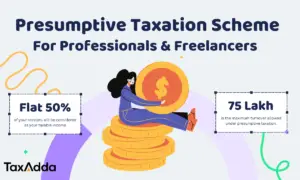National Pension Scheme (NPS) is launched with the objective of providing retirement income to the government employees on 01st January 2004. It is a government sponsored pension scheme initially launched for Government employee but from 01st May 2009 the scheme was opened for all the citizens of India. NPS aims to generate habit of savings for retirement amongst Indian citizens.
Who can join NPS
Any citizen of India, whether resident or non-resident, having age between 18 to 65 years as on date of application. The citizen can join NPS either as individuals (in this case only individual can contribute) or as on employee-employer groups(s) (employer can also co-contribute for the social security/welfare of the individual).
Return under NPS
No fixed interest rate has been set for NPS scheme. It is because NPS scheme picks and chose various different investment options. Just for a benchmark, NPS scheme earned interest rate of upto 12% to 14% depending on the scheme selected. There is no fixed defined benefits that would be available at the time of exist. The accumulated wealth completely depends on the contributions made and income generated from the investment of such contribution over the period.
Register under NPS
NPS is distributed through authorised entities which are called Point of Presence (POP’s) and almost all the private and public sectors bank along with various other financial institutions such as Post Office, Life Insurance Corporation, Bajaj Finserv etc are enrolled as Point of Presence Service Provider (POP-SPs). A NPS account is required to be opened through these POP-SPs for the purpose of investment in NPS scheme. You can get the address of your nearest registered POP-SPs from this link – https://www.npscra.nsdl.co.in/pop-sp.php
NPS Account
Under the NPS, a subscriber will get a unique Permanent Retirement Account Number (PRAN). This is unique account number which will remain the same for the rest of the subscriber’s life. PRAN will provide access to two personal investment account called Tier I Account & Tier II Account.
| Tier I Account | Tier II Account |
| Mandatory to open in order to register under NPS | Optional account which can be opened anytime by the subscriber |
| It is also known as Pension Account | It is also known as Investment Account |
| Restriction on withdrawal from his account. Withdrawal is permitted after 10 years of the account opening or attaining the age of 60 years whichever comes early | No restriction on withdrawal from this account. Withdrawal can be done at any point of time as per the need of subscriber. |
| Income tax benefit is available on the contribution made | No income tax benefit is available on the contribution made |
| Minimum annual contribution require is Rs 1,000 for this account | No minimum annual contribution is required for this account |
Investment of Funds under NPS
Subscriber can invest his funds in the following four class of assets: –
- Asset Class E – Equity market instruments
- Asset Class C – Investment in fixed income other than Government securities such as Corporate Bonds, Debentures etc.
- Asset Class G – Investment in Government Securities
- Asset Class A – Alternative Investment Schemes including instruments like CMBS, MBS, REITS, AIFs etc.
Choice of Investment
Active Choice – Subscriber has the option to decide his own asset mix with a restriction of maximum 50% exposure in Asset Class E and maximum 5% in Asset Class A of his entire pension wealth. Subscribe has the choice to invest his entire pension wealth in Asset Class C or G.
Auto Choice – Subscribe can also select from the standard available options known as Life Cycle Fund. This is a default option under NPS and wherein the investment of funds is done automatically based on the age profile of the subscriber. Three Life Cycle funds are available under this Auto Choice: –
- LC75 (Aggressive Life Cycle Fund) – In this Life Cycle Fund, the exposure in Equity Investments starts with 75% till age 35 and gradually reduces as per the age of the subscriber.
- LC50 (Moderate Life Cycle Fund) – In this Life Cycle Fund, the exposure in Equity Investments starts with 50% till age 35 and gradually reduces as per the age of the subscriber. This is the default option if subscriber do not select any Life Cycle Funds.
- LC25 (Conservative Life Cycle Fund) – In this Life Cycle Fund, the exposure in Equity Investments starts with 25% till age 35 and gradually reduces as per the age of the subscriber.
Pension Fund Manager
Money invested in NPS by subscribers is managed by Pension Fund Regulatory and Development Authority (PFRDA) registered Pension Fund Manager (PFM’s) as per the investment guideline provided by PFRDA. At present, subscriber has option to select any one of the following 8 pension funds managers: –
- ICICI Prudential Pension Fund
- LIC Pension Fund
- Kotak Mahindra Pension Fund
- Reliance Capital Pension Fund
- SBI Pension Fund
- UTI Retirement Solutions Pension Fund LIC Pension Fund
- HDFC Pension Management Company
- DSP Blackrock Pension Fund Managers
Note:- If subscriber do not select any PFM then as per the default provisions, SBI Pension Fund will act as a default PFM. This list will get updated from time to time once the PFRDA register any new PFM.
Minimum Contribution in NPS
| All Citizen Model | Tier I Account | Tier II Account |
| Minimum contribution at the time of account opening | Rs 500 | Rs 1000 |
| Minimum amount per contribution | Rs 500 | Rs 250 |
| Minimum total contribution per year | Rs 1000 | – |
| Minimum frequency of contribution | 1 per year | – |
Charges Applicable in NPS
NPS provide low cost option for planning retirement to all Indian citizen. NPS perhaps is the world’s lowest cost retirement saving product. There are various agencies under NPS which are as follows: –
- CRA – The recordkeeping, administration and customer service functions for all subscribers of the NPS are being handled by the National Securities Depository Limited (NSDL) and Karvy Computershare Private Limited (Karvy).
- Custodian – Custodian mean “Custodian of Securities” who has been granted a certificate of registration by PFRDA of providing custodial and depository participant services for the pension scheme regulated by PFRDA.
- NPS Trust – The NPS trust has been setup and constituted for taking care of the assets and funds under the National Pension System in the interest of the beneficiaries (subscribers).
Following are the current charges under NPS
| Intermediary | All Citizen Model | Charges | Frequency |
| POP | Initial Subscriber Registration | Rs 200 | One Time |
| POP | Initial Contribution/All Subsequent Contribution | 0.25% of the Contribution amount (Minimum Rs 20 & Maximum Rs 25,000) | As required |
| POP | All Non-Financial Transaction | Rs 20 | As required |
| POP | Persistency Charges | Rs 50 | Annually |
| CRA | PRA Opening | Rs 40 (NSDL)
Rs 39.36 (Karvy) |
One Time |
| CRA | PRA Maintenance | Rs 95 (NSDL)
Rs 57.63 (Karvy) |
Annually |
| CRA | Financial/Non-Financial transaction | Rs 3.75 (NSDL)
Rs 3.36 (Karvy) |
As required |
| Custodian | Asset Serving | 0.0032% of Asset under Custody | Annually |
| Pension Fund Managers | Investment Management | 0.01% of Asset under Management | Annually |
| NPS Trust | Reimbursement of Expenses | 0.01% of Asset under Management | Annually |
Note: – The above charges exclude applicable GST as per existing tax laws. There are no additional CRA charges for the maintenance of Tier –II account.
Tax Benefit under NPS
Contribution made to Tier-I Account
- Salaried Employee – Employee own contribution upto 10% of the salary (basic plus dearness allowance) are tax deductible under section 80CCD(1) of the Income Tax Act subject to a ceiling of Rs 1,50,000 under section 80CCE. Employer contribution upto 10% of the salary (basic plus dearness allowance) are tax deductible under section 80CCD(2) of the Income Tax Act. There is no upper limit on this tax deduction on the amount contributed by employer. This deduction is over and above the ceiling limit of Rs 1,50,000 provided under Section 80C.
- Self Employed Person – Contribution upto 20% of the Gross Income of the self employed is deductible from the taxable income under section 80CCD(1) of the Income Tax Act subject to ceiling of Rs 1,50,000 under section 80CCE.
Note: – Additional deduction for investment upto Rs 50,000 has been provided under section 80CCD(1B) of the Income Tax Act which is over and above the ceiling limit of Rs 1,50,000. Therefore, the total deduction that can be claimed for own contribution can go upto Rs 2,00,000. No deduction is available under income tax for the contribution made to Tier-II account.
Withdrawal from NPS account
- Tier I Account
- Upto 40% of corpus withdraw in lump sum is exempt from tax.
- Balance amount invested in Annuity us also exempt from tax
- Pension received out of investment in Annuity is treated as income and will be taxed accordingly.
- Tier II Account – No special tax benefit is available. However subscribed can claim indexation benefit as available in the Income Tax Act.
Exist from NPS Account
- Upon attainment of the age of 60 years
- At least 40% of the accumulated corpus need to be utilized for the purchase of annuity providing for monthly pension of the subscriber.
- The balance 60% can be paid as a lump sum payment to the subscriber. If the corpus is less than Rs 2 Lakh then the subscriber may opt for 100% lump sum withdrawal.
- At any time before attainment the age of 60 years but after completing 10 years of NPS account
- At least 80% of the accumulated corpus need to be utilized for the purchase of annuity providing for monthly pension of the subscriber.
- The balance 20% can be paid as a lump sum payment to the subscriber. If the corpus is less than Rs 1 Lakh then the subscriber may opt for 100% lump sum withdrawal.
- Death of subscriber
In such event, nominee can opt to receive 100% of the accumulated corpus in lump sum. Nominee can also opt to continue with the NPS, in such case he have to subscribe to NPS individually.
Partial Withdraw from NPS
In the whole lifespan, 3 partial withdrawals are allowed from Tier I Account before attainment of 60 years of age subject to following conditions: –
- First partial withdrawal is allowed only after 3 years of NPS account opening
- Maximum 25% of own contribution (excluding employer contribution or any earnings on investment) standing in his name as on date of application for withdrawal
- Partial withdraw is allowed only for the following reason
- Higher education of the children
- On the occasion of marriage of children
- Purchase or construction of a residential house or flat
- Treatment of specified illness for himself, spouse or children such as cancer, coma, major organ transplant, kidney failure, heart valve surgery etc
Annuity Service Providers under NPS
Following are the currently registered Annuity Service Provider (ASPs) from which subscriber has the option to select any of them at the time of exiting from NPS scheme: –
- Life Insurance Corporation of India
- SBI Life Insurance Co. Ltd
- ICICI Prudential Life Insurance Co. Ltd
- Star Union Dai-ichi Life Insurance Co. Ltd
- HDFC Standard Life Insurance Co. Ltd
Note: – These ASPs provide variety of annuity plan from which subscriber can select the annuity plan subject to certain standard terms and conditions as imposed by PFRDA.

